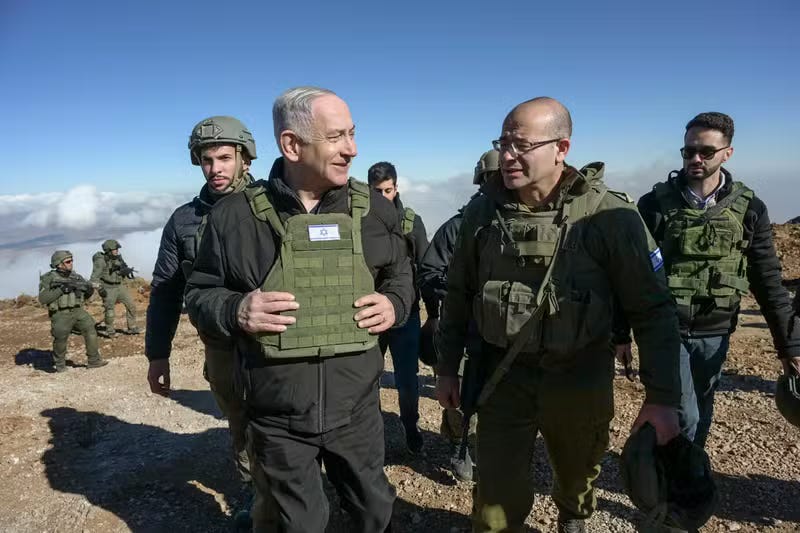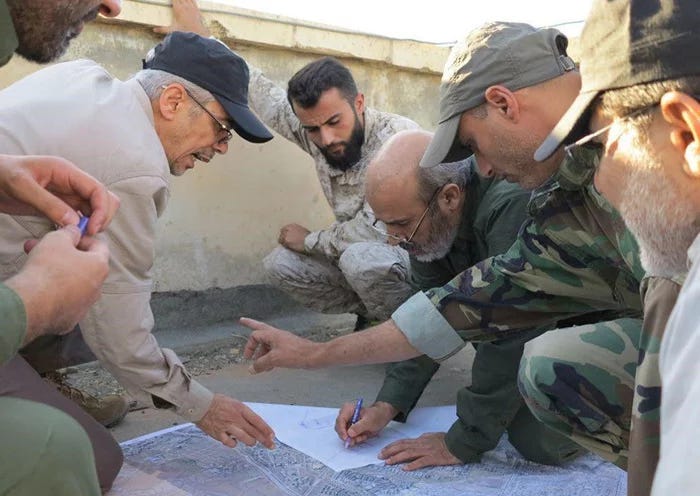Since the outbreak of the Syrian revolution in 2011, Iran has played a pivotal role in bolstering Bashar al‑Assad’s regime—politically and militarily—by funding and arming sectarian militias and providing the intelligence and technical support needed to suppress the popular uprising.
Syria quickly became a central theater of Iran’s regional hegemony, where battles were fought not in the name of Syrian freedom but under foreign flags and with foreign blood.
Tehran deployed transnational militias—Fatemiyoun, Zainabiyoun, Hezbollah, among others—turning what began as resistance into a sectarian war. These forces intensified societal divisions, reinforced the regime’s brutality, and committed massacres, besieged cities, and reshaped the demographic structure in line with a sectarian agenda entirely divorced from Syrians’ aspirations.
Today, as tensions escalate between Iran and Israel, Syrians witness Iranian figures stained with civilian blood being struck down—not in a liberation struggle but in a long-simmering regional–international rivalry now coming to a head. Those recently assassinated in Iran were the same commanders overseeing brutal suppression in Deir ez-Zor and Damascus.
Syris’s schadenfreude at their deaths is understandable—but it must not obscure a critical question: Will Syria become a victim again? Iran’s absence does not necessarily equate to Syrian strength—militarily, institutionally, or structurally. Instead, it opens a vacuum ready for another power to fill, one that has long treated Syria as empty terrain.
Numbers That Reveal Syrian Resentment Toward Iran
Although hard to separate from the regime’s own crimes, Iran’s involvement is starkly evident via open-source data:
Iran’s manpower in Syria: Between 2015 and 2018, approximately 1,000–2,000 regular Iranian Revolutionary Guard officers and soldiers supervised 20,000–25,000 foreign fighters from Hezbollah, Fatemiyoun, and Zainabiyoun, plus thousands more from Assad’s army under direct Iranian command.
Military presence: By mid-2024, field studies documented 52 permanent Iranian bases and 477 outposts/checkpoints across 14 provinces—down from over 500 logistical points and bases in 2023.
Financial backing: Research institutes estimate Iran’s direct funding to Assad and allied militias at around $16 billion between 2012 and 2018; later official assessments suggest totals approaching $30 billion by 2020.
Iranian casualties: In 2016, Tehran acknowledged over a thousand deaths—including senior IRGC officers—with hundreds more from Afghan and Pakistani militias killed in later years.
Logistical hubs: Iran relied on a land corridor from Albukamal/Al-Qaim through Syria into Lebanon, supported by key nodes like T-4 Airport near Homs and Jabal al-Azān near Aleppo—frequent targets of Israeli and U.S. strikes.
Human toll: The Syrian Network for Human Rights recorded 4,162 civilian deaths in 2018 alone—713 children and 562 women—among tens of thousands killed from 2013 onward in areas like al-Qusayr, the Ghouta, Aleppo, and Deir ez-Zor.
Looting and destruction: Since 2019, widespread looting was documented in dozens of districts of Aleppo and Hama, carried out by regime forces and Iranian militias—recognized as war crimes.
Demographic engineering: The 2017 “Four Towns Agreement” (Kafarya/Fu’ah ↔ Zabadani/Madaya) led to Sunni displacement west of Damascus and replacement by pro-Iranian families.
Law 10 of 2018: Gave the regime power to declare areas as urban development zones and seize property of absent owners within 30 days—threatening nearly ten million people and enabling sales to investors linked to Iran and Hezbollah.
Sectarian resettlement: Reports show Iraqi Shiite families moved into Darayya and Damascus environs after original residents were displaced—part of Iran’s plan to reshape demographics around the capital.
Economic control: In 2017, the regime signed deals granting Iran access to phosphate mines at Khanīfīs and Al-Sharqiya near Palmyra, as well as ports and energy projects—later derailed by the regime’s collapse in late 2024.
What Iran left behind: By the end of 2024, Tehran left behind destroyed positions, newly built imam‑husseiniyas and religious schools, emptied neighborhoods, plus investment debts and corruption linked to hundreds of millions—now to be examined by Syria’s new government.
From Schadenfreude to a Defining Question
Firstly, Syrians’ animosity is not toward the Iranian people, but toward Iran’s political and military leadership—the architects of war and repression. Many Syrians sympathize with ordinary Iranians, who—like them—have endured a repressive system. The widespread protests following Mahsa Amini’s death are a vivid reminder .
Israeli strikes on Iranian figures in Syria, Lebanon, and Tehran have sparked jubilation among Syrians—an outburst of pent-up anger over the sectarian war imposed on them. Yet this joy conceals a worrying reality: neither Iran’s departure nor Israel’s actions amount to liberation.

Israel too uses Syrian land for regional plays, showing scant regard for Syrian sovereignty. Without Iranian deterrence, Israeli dominance grows quietly and technologically sophisticated.
So Syria now faces a grave question: Who will fill the vacuum? Who will draw the lines of power? Without learning from the first occupation, Syria risks enduring a second, perhaps even harsher, under a new flag.
Israel in the Vacant Space: An Enemy Without Limits
Iran’s decline in Syria is not a moment of liberation, but a moment of revelation—exposing Syria’s fragility and the absence of a real deterrent against another encroaching regional power.
Israel today strikes as it pleases, with no military counterweight, no political cover, not even fear of retaliation. The only thing preventing the next strike is a Tel Aviv decision—not Damascus capability.
Transitioning from a sectarian occupation by the East to technical dominance by the South does not signal genuine transformation—only a change in jailer. Both occupy Syria’s sovereignty, viewing it as a testing ground or soft underbelly, not a nation with its own agency and interests.
If Israel continues reshaping the regional order, Syria will face not just an occupying military power, but an invisible yet effective presence, one governed by a new deterrence model written in silence and unchallenged by others.
Syrians May Be Unarmed… But Not Without a Stance
Syrians today may lack an army, air defenses, or global backing—but they possess something far more potent: awareness. They understand that sovereignty extends beyond territorial control—it’s about narrative, stance, and political direction that rejects being pawned under any pretext.
What’s needed now isn’t neutrality—though understandable given the power asymmetry—but a sovereignty-based discourse: refusing to be anyone’s tool. Syria must rebuild internally, reclaim its national story, and assert its political and media voice. Resistance needn’t be armed—it can be a clear vision, a defined position, an unwavering refusal to be replicated in another form.

Iran was a bloody occupation. Israel is no less dangerous in its methods and aims. Whoever did not learn from the first experience is destined to endure the second—and at an even higher cost.
What we see today in the Iranian collapse and its failing proxies in Syria and Lebanon is not an effortless victory—but the bitter fruit of Syrian blood unjustly shed. No law protected them, no world heard their screams—but history will testify: those who betray Syrian lives won’t escape reckoning—and across the water, the Southern enemy’s time will come too. The blood spilled in Gaza may one day bring a reckoning that matches its weight—and blood’s curse is hard to outrun.



